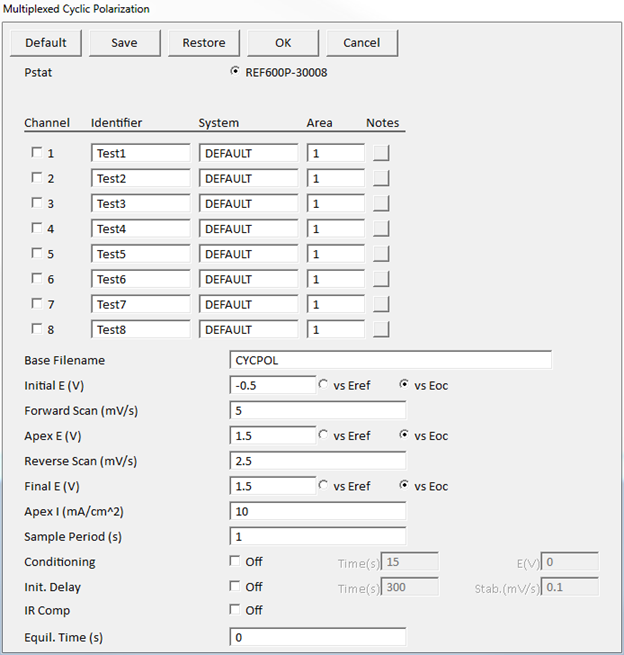Multiplexed Cyclic Polarization Setup Parameters
Here is the Multiplexed Cyclic Polarization Setup dialog box complete with its default parameters.

Pstat, Multiplexer
- Select your Pstat and Multiplexer using the labeled radio buttons. You may select only one device of each type. Unavailable devices are grayed out. NOTE: Be careful—the multiplexer and potentiostat that you select must be connected together!
Channel
- There is one channel setup switch for each of the eight channels. When channel switch N is selected, an X appears in the checkbox for that channel. As the script loops through the channels, it only run tests on channels that are selected. The numbers for selected channels need not be continuous.
Identifier
- A string that is used for two purposes. The Identifier parameter is written to the data file, so it can be used to identify data in database or data-manipulation programs. The Identifier string is also used as the title for both real-time plots and plots in the data-analysis software.The Identifier string defaults a name derived from the technique’s name. While this makes an acceptable curve-label, it does not generate a unique descriptive label for a data set.The Identifier string is limited to 80 characters. It can include all normally printable characters, including numbers, upper- and lower-case letters, and most normal punctuation including spaces.
Area
- The electrode area used in calculations. Each channel can have a different area. Notes

- Enter several lines of text that describe the experiment. A typical use of Notes is to record the experimental conditions for a data set.To the right of the notes is a button, which allows you to open the Experiment Notes dialog box, shown below, to show more of the notes at one time. You can edit the notes in either place.

- Notes defaults to an empty string.The Notes string is limited to 400 characters. It can include all printable characters including numbers, upper- and lower-case letters, and the most normal punctuation including spaces. Tab characters are not allowed in the Notes string.You can divide your Notes into lines using enter.
System
- Selects a set of electrochemical parameters relevant to your particular test system. The parameters are recovered from the system-parameter database file. The recovered parameters are all used in the calculation of corrosion rate. They are the sample’s equivalent weight, density, anodic β and cathodic β. When you attempt to run an experiment, the system searches the SYSTEM.SET file for a parameter set stored under the System name. If the software finds no parameter set, an error message is displayed and you are returned to the Setup dialog box.
Sample Period
- The time between each loop through the channels. For example, if the first loop begins at 2:08 and the Sample Period is 30 minutes, additional loops start at 2:38, 3:08, 3:38, etc. If the test time is relatively constant, it is also the approximate time between tests on a single channel. The Sample Period is always entered in minutes. Enter fractional minutes as decimal numbers. The Sample Period must be longer than the time required to run through the test loop. When you click the OK button in the Setup dialog box, the script estimates the time required for the loop. If this time is close to or longer than the entered Sample Period, the Framework generates an error message and returns you to Setup.
Total Time
- The duration of the experimental run. The script keeps track of elapsed time since the start of the experiment. At the start of each test, this time is compared to the Total Time. If the elapsed time is greater than or equal to the Total Time, the experiment is terminated. The Total Time is always entered in hours. Enter fractional hours as decimal numbers. If you want to run one single test, enter a Total Time equal to the sample period. If you want N tests on each cell, enter a Total Time equal to N × sample period.
Base Filename
- Each channel has its own data file. The Base Filename is used to derive the filenames for these files. The filename for channel N (1–8) is made up by appending the character N to the Base Filename, then adding a .DTA filename extension. For example, if the Base Filename is MYMUXDATA, the data file for channel 1 is named MYMUXDATA1.DTA.The filename resulting from the concatenation of the Base Filename and the channel number must adhere to Windows® filename conventions. Avoid punctuation characters (the underscore, “_”, is OK). You are allowed a maximum of 250 (not 255) characters in the Base Filename. The extra characters are reserved for the channel number appended to the Base Filename. Do not include .DTA when specifying the Base Filename. It is automatically added when the full data file name is generated.
Initial E, Forward Scan, Apex E, Reverse Scan, Final E, Apex I, Conditioning, Init. Delay, IR Comp, Equil.
- Time All of these parameters have the same meaning as in the DC Corrosion software.

Comments are closed.